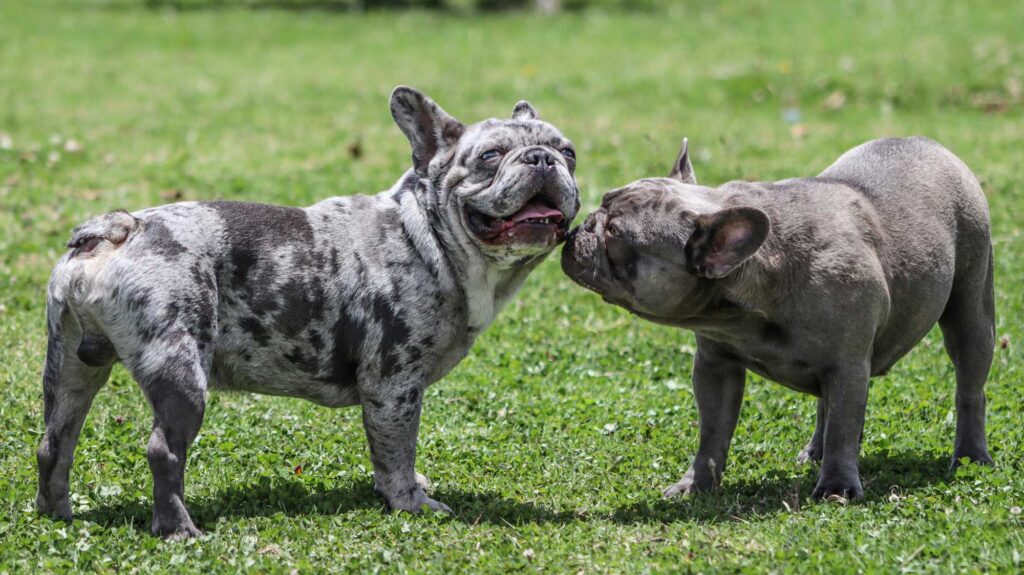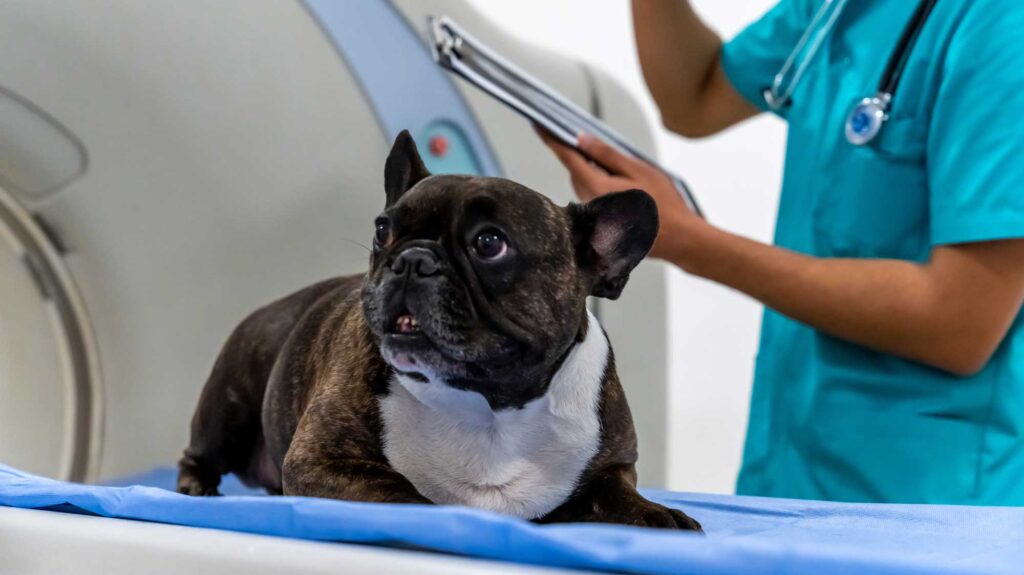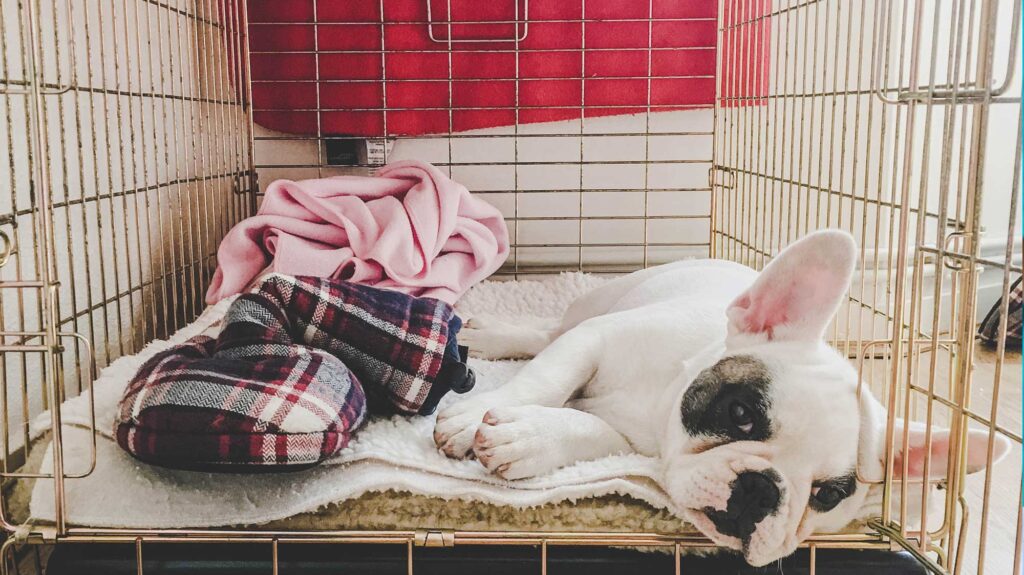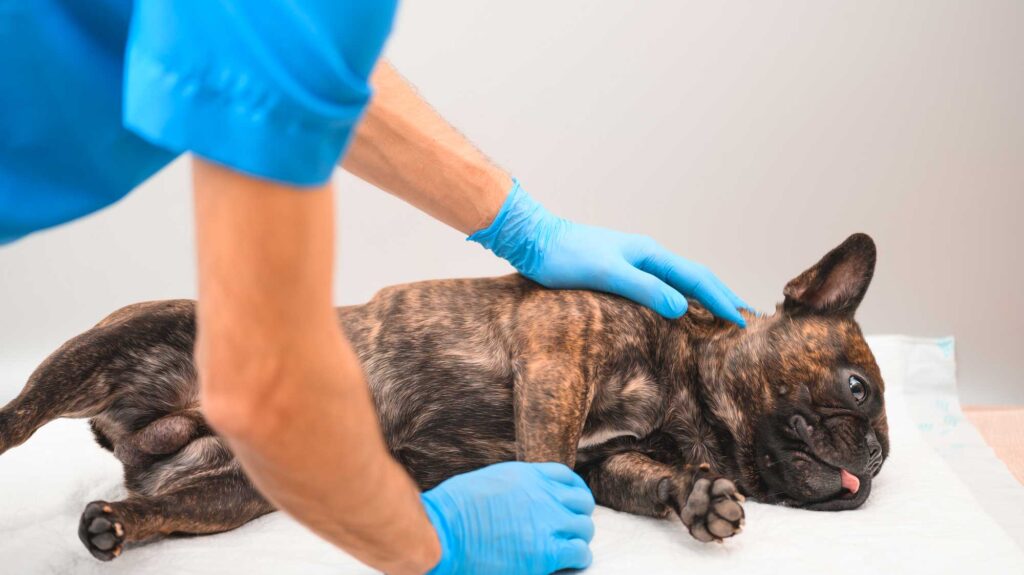- What is French Bulldog IVDD?
- What Are the Signs of French Bulldog IVDD?
- How can Frenchie IVDD be diagnosed?
- How Early Detection of Intervertebral Disc Disease Can Improve Prognosis
- What Treatment Options are Available for IVDD in French Bulldogs?
- French Bulldog IVDD Life Expectancy
- What is the Prognosis for French Bulldogs with IVDD?
- Can French Bulldog IVDD be Prevented?
- Long-term Management of IVDD in French Bulldogs
- FAQ

French bulldog IVDD or Intervertebral Disc Disease (IVDD) is a devastating condition which French bulldogs are genetically predisposed to.
Unfortunately the way Frenchies have been bred has led to a variety of medical issues within the breed which we talk about freely on this site. Frenchies are prone to many health conditions IVDD being one of the most prevalent. So rather than burying your head in the sand and hoping your Frenchie won’t get IVDD, learn the warning signs and symptoms so that you can act quickly before it’s too late for your beloved fury friend.This article will dive deep into French Bulldog IVDD; how you can spot the signs, the risk of IVDD for your dog, what treatment involves and the prognosis of this orthopedic disorder.
What is French Bulldog IVDD?
Intervertebral disc disease affects French Bulldogs more often than any other breed. In some emergency centers, they represent a whopping two thirds of all admitted patients with IVDD (1).
In one study where Frenchies were brought to the vet for displaying neurological signs, almost half of these were ultimately diagnosed with IVDD (2).
Understanding Intervertebral Disc Disease
There are shock absorbers in between a dog’s back bones (vertebrae) called discs. When these discs are damaged or worn down, they can bulge or burst. This puts pressure on the spinal cord leading to signs including weakness and paralysis.
How IVDD Affects the Spinal Cord in French Bulldogs
There are two categories of IVDD: Hansen Type One and Hansen Type Two. It is the first type that is typically seen in Frenchies (3). Their discs harden and become brittle over time until the material inside them, before the contents suddenly ‘burst’ out and enter the spinal canal.
Why French Bulldogs are Prone to IVDD
IVDD typically occurs in some breeds more than others, those more susceptible include the Frenchie, Pug and Dachshund. This is due to their body shape with short legs and long bodies. French Bulldogs are a chondrodystrophic (dwarf) breed, which makes their discs more prone to calcification and degeneration.

On top of this, their dense muscles and any extra fat they are carrying, can put pressure on the spine. These dogs are prone to obesity, with some research finding them to represent the dog breeds with the highest body condition score (4).
What Are the Signs of French Bulldog IVDD?
It is important that you know the common signs to lookout for when it comes to IVDD. This is because early diagnosis and treatment for French bulldogs can lead to better outcomes for your dog. Preventing further damage and giving them the best chance of recovery.
Identifying Early Signs of IVDD in French Bulldogs
What signs come on first will depend on the individual case. For some dogs, symptoms are subtle at first, while other dogs become paralysed immediately.
Common Symptoms of IVDD disease in French Bulldogs
Symptoms of an IVDD flare up include:
- Lethargy and reluctance to move
- Limping or sometimes French bulldogs may drag their hind legs
- Weakness and wobbliness
- Standing hunched over
- Reduced appetite
- Paw dragging
- Flinching or whimpering when touched, showing signs of pain
- Tremors
- Incontinence
Keep in mind that signs vary and not every dog is going to exhibit every sign.
When to Seek Veterinary Care
You should have your Frenchie assessed urgently, as soon as you notice any signs. This is to achieve a diagnosis quickly, and also so your dog can get the pain relief (and other treatments) that they need.
How can Frenchie IVDD be diagnosed?
Diagnosis is not always straight forward as conditions like myelopathies, ear infections and other French Bulldog back problems (such as muscle strains) can all be mistaken for IVDD.
Veterinary Exams and Tests for Diagnosing IVDD
When you are first seen by your vet, we’ll ask about your dog’s medical history and signs and will also check them over. As well as performing a physical exam, we will assess the dog’s orthopedic and neurological function. If concerned for a slipped disc, we will likely advise on urgent imaging of their spine.
The Role of MRI in Diagnosing IVDD
Certain imaging studies (5) are more effective than others at diagnosing IVDD. X-rays, myelography, CT scans and MRIs can all play a role to some degree. While MRI studies are the most costly and require anesthetic, they are seen as the gold standard in diagnostics.
MRI allows your vet to visualize the spinal cord and can diagnose IVDD with great accuracy. Still, CT scans are valuable as they are cheaper and quicker to perform.

How Early Detection of Intervertebral Disc Disease Can Improve Prognosis
It is widely accepted that early detection and treatment is directly related to better outcomes for the affected dog (6,7).
The Importance of Early Detection & Treatment
By identifying and treating IVDD shortly after it occurs, helps reduce the chances of it progressing. By limiting further damage to the spinal cord, function can be preserved.
How to recognize the symptoms of IVDD in French Bulldogs?
As a Frenchie owner, you should try to be conscious of how your dog moves and should be on the lookout for subtle changes in their mobility and posture.
Behavioral Changes Indicating IVDD
Even before your dog shows signs of a limp or weakness, you may notice changes in your French bulldog’s behaviour. This can include your Frenchie hiding away or being less active. They may also pant, whine or tense up when touched. Some dogs become anxious, while others are aggressive due to the pain they are feeling.
How do I know if my French Bulldog has a back injury?
Dogs are good at masking signs of pain and hiding symptoms. However, you may recognise signs including stiffness, a change in posture, a limp or lethargy.
How do I know if my French Bulldog has a slipped disc?
A slipped disc can only be diagnosed with an imaging study such as an MRI scan. Still, you may be suspicious your Frenchie has a slipped disc if they suddenly develop signs of back issues such as weakness or limb dragging.
What does stage one IVDD look like?
It can be useful to divide IVDD into five stages, which help dictate the treatment plan and prognosis:
| Stage I | Mild pain is felt but there are no neurological deficits |
| Stage II | While dogs can walk, they are uncoordinated and there is moderate to severe pain |
| Stage III | The dog has partial paralysis, though can move their limbs |
| Stage IV | Though the dog cannot move their limbs, they feel deep pain |
| Stage V | Dogs can neither move their limbs nor feel deep pain. |
How fast does IVDD progress?
IVDD may not always a predictable disease and every individual experiences a different trajectory. As Hansen Type I lesions are common in French bulldogs, signs can progress rapidly within hours or days.
When to Consult a Vet
Several studies (6,7) have shown that the sooner you intervene, the better the prognosis. Indeed, providing early treatment may even reduce the need for surgery in some patients.

What Treatment Options are Available for IVDD in French Bulldogs?
IVDD can vary from mild to severe, so the ideal therapy will depend on your dog’s age, any underlying medical issues they have, your financial situation and the extent of the IVDD.
Non-Surgical Treatment Options
For some patients, the first treatment option is crate rest and medication. This may be all that is needed, particularly if they have a milder case of IVDD. Medicine can include pain relief, anti-inflammatories and muscle relaxants.
Surgical Interventions
Surgery is often indicated for those Frenchies who are showing neurological deficits. This would be performed by a specialist and the technique used varies depending on the type of IVDD and the surgeon’s preference.
Post-Treatment Care and Crate Rest
Once back home, recovery is only just beginning. Most dogs are seen for regular check-ups and need to be kept in a crate for several weeks, to enable proper healing.
What Is the Likelihood of Successful Treatment for IVDD in French Bulldogs?
Success rates increase with milder lesions and more timely interventions. Surgery is more successful than conservative management in later stages of the disease. Sadly, for those lacking deep pain perception, there is a lower chance of surgery being successful.
What is the average French bulldog IVDD surgery cost?
Milder cases of IVDD managed with rest and medicine may only set you back a few hundred dollars. However, for dogs requiring MRI scans and surgery, expenses can reach up to $12,000 (8).
Dog spinal surgery cost will be higher in certain parts of the world but is notorious for being expensive. These high costs of care for French Bulldog health issues is one of the reasons we recommend every Frenchie owner has pet health insurance. Learn more about the best pet insurance for french bulldogs here.
How long does it take for a French bulldog to recover from IVDD?
Your pet’s recovery time can be anything from a few days to many months, depending on how badly the spinal cord has been damaged. Some dogs will require ongoing care, rehabilitation and physiotherapy.
What is the Prognosis for French Bulldogs with IVDD?
Keep in mind that each dog is an individual, and prognoses are going to vary hugely. Talk to your vet directly about your own dog’s chance of recovery.
Factors Influencing Prognosis
Your dog’s age, weight, and general health will have a big impact on their prognosis.
Vets will also be considering things like the presence of deep pain, continence and the development of myelomalacia (softening of the spinal cord).
French Bulldog IVDD Life Expectancy
Frenchies with IVDD can still have a good quality of life with a good life expectancy if they get the proper care and management. French bulldog IVDD life expectancy comes down to these key factors:
- severity of the condition
- timing of the appropriate treatment
- quality of ongoing preventative care
For the milder cases where a Frenchie receives quick diagnosis and treatment you can expect your dog to live close to their normal life expectancy of 10-12 years. Milder cases generally respond well to a management treatment plan including rest, pain medication and physical therapy. The most important factor is the prevention of further disc herniations which can be achieved through lifestyle changes.
In the more severe cases where surgery is required life expectancy varies:
- If a French Bulldog receives quick surgical intervention (within 24-48hours of severe symptoms) this will result in the best outcomes. If surgery is successful and they receive the proper post surgery care they can have a good quality of life for several more years.
- There is a much poorer prognosis for Frenchies with severe symptoms who do not have surgery, this significantly impacts their life expectancy.
Overall, French Bulldog life expectancy is on the lower end for our canine friends being published to be about 10 years (not great for a small breed). Shockingly, one UK study found this figure to be much lower: 4.5 years (9). It is highly likely that IVDD plays a big role in this.
Can French Bulldog IVDD be Prevented?
Of course, the million dollar question for you as an owner, is how you can stop your Frenchie developing IVDD. Let’s take a look:
How do you prevent IVDD in French Bulldogs?
You cannot always prevent IVDD, but there are certain things that may help. These include:
- Weight management
- Proper nutrition and the use of joint supplements
- The use of appropriate body harnesses and collars
- Avoiding big steps and high jumps
- Consistent exercise that does not strain the spine
- Regular vet checks
- Avoiding high-impact activities where possible
- Removing those affected from the breeding pool
Importance of Regular Veterinary Check-Ups
Seeing your vet every 6-12 months can help ensure your dog is showing no signs of joint disease and is a great way of monitoring their weight and body condition score.
‘IVDD Frenchies’ are dogs vets will pay special attention to, as recurrence occurs in more than half of patients (11).

Long-term Management of IVDD in French Bulldogs
In the long-term, weight management and physical therapy play a big role in healing. Some patients may also benefit from ramps, orthopedic beds and non-slip mats within their home. Of course, regular vet checks are also a must.
When should you euthanize a dog with IVDD?
Very sadly, not every dog will survive IVDD and sometime the call has to be made to put them to sleep. The decision to euthanize is often complex and fraught with guilt and internal struggle.
It is best to have a frank conversation with your vet, who will consider othings including the extent of the IVDD, the chance of recovery and your dog’s general wellbeing.
FAQ
How likely is my Frenchie to get IVDD?
While this specific study has not yet been carried out, we can theorize that the rate may be similar to the rate in the Dachshund, which is about 20%.
Do all French Bulldogs have IVDD?
Though IVDD is prevalent in this breed, not all individuals will develop it.
How can I make my home more comfortable for a French Bulldog with IVDD? Should I get dog ramps?
If your dog has IVDD, they will initially be kept in a crate. As they become more mobile, it can be very helpful to use things including non-slip mats, stair gates and ramps.
What age do French bulldogs get IVDD?
The average age at onset is 4 years old (2), but it is also a disease that can affect senior Frenchies.
Is French Bulldog IVDD the only back issue they experience?
French Bulldog spine issues are not limited to IVDD, and vets also encounter a range of other conditions including hemivertebrae, spinal stenosis and spondylosis deformans.
-
- De Decker, S., da Costa, R.C., Volk, H.A., Bui, T., Balogh, G., & Chan, A (2022). Prevalence, clinical features, and outcome of intervertebral disc extrusion associated with extensive epidural hemorrhage in a population of French Bulldogs compared to Dachshunds.
-
- Fenn, J., Drees, R., Volk, H.A., & De Decker, S. Prevalence of neurological disorders in French bulldog: a retrospective study of 343 cases (2002–2016).
-
- Clare Rusbridge (2015). Canine chondrodystrophic intervertebral disc disease (Hansen type I disc disease).
-
- Lund, E.M., Armstrong, P.J., Kirk, C.A., & Klausner, J.S. (2021). Overweight in Swedish show dogs–prevalence and association with performance in competition.
-
- De Decker, S., da Costa, R.C., Volk, Lewis. (2020). Diagnostic Imaging in Intervertebral Disc Disease.
-
- Dr Olby N.J et al. (2016) Impact of Early Surgical Intervention on Neurological Recovery in Dogs with IVDD.
-
- Dr Olby N.J et al. (2018) Evaluation of Early Clinical Signs and Their Role in Predicting the Severity of IVDD. Journal of Veterinary Internal Medicine.
-
- Degenerative Disc Disease in Dogs. Available at: https://wagwalking.com/condition/degenerative-disc-disease-in-dogs.
-
- Teng, K. T., Brodbelt, D. C., Pegram, C., Church, D. B., & O’Neill, D. G. (2022). Life tables of annual life expectancy and mortality for companion dogs in the United Kingdom. Scientific Reports, 12, Article 6415
-
- Olby, N.J., da Costa, R.C., Levine, J.M., Stein, V.M., & the Canine Spinal Cord Injury Consortium (CANSORT SCI). (2020) Prognostic Factors in Canine Acute Intervertebral Disc Disease.
-
- Leu, D., Vidondo, B., Stein, V., & Forterre, F. (2023) ‘Recurrence rate of intervertebral disc disease in surgically treated French Bulldogs: a retrospective study (2009–2019)’.
 Dr Linda Simon
Dr Linda Simon


